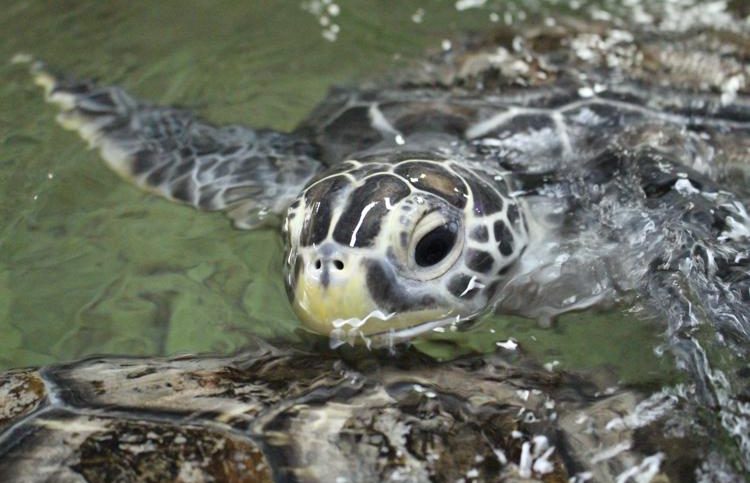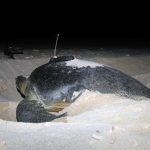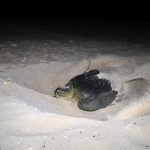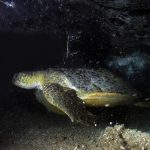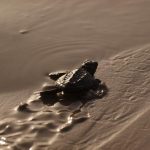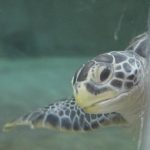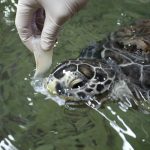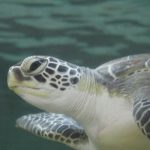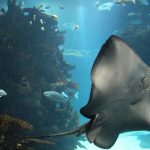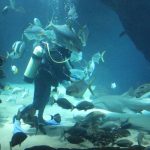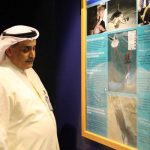Her large paddle-like flippers hit the sand at the edge of the shore of Qaru. She had made the over 85-kilometer journey south from her feeding spot off the coast of Failaka, but the difficulties had just begun. It was easy for her to glide her body underwater, though she weighed more than 200 kgs. On the wet sand however, gravity took its toll.
Out of the water she emerged, at the speed one can only expect from a sea turtle out of water. With each step she grunted and moaned, but nothing could stop her. The moon was rising behind her, and she needed to be done before the sun rose over the horizon. Finally, she reached the edge of the wet sand, away from the tide, and began to dig.
Her large hind flippers moved back and forth, sweeping away the dry sand. Soon she was encapsulated in brown waves on either side, until the hole was almost 50 centimeters deep. She stopped and began to lay her soft shell eggs, her grunts and heavy breathing only disturbed by the breaking waves behind her. With the last of her 110 eggs secured in the sand, she covered the clutch, and hid it from the predators that were sure to wander around the beach the next morning. It had been almost three hours when she once again felt the weightlessness of the ocean water, and left her young ones alone buried on the beach.
According to Yaarub Al-Yahya, Aquarium Curator in Kuwait’s The Scientific Center, watching a sea turtle laying her eggs is an incredible event.
“It’s a very tiring process for her,” he said. “You can hear her voice moaning when she is going up and trying and trying, and heavy breathing when she is laying her eggs. She will not move even if you touch her. She came for a reason and she wants to finish it and go back to the sea.”
Sea turtles are one of the largest reptiles in the world, and are found in almost every ocean. In 2008 scientists studying an excavated rock from the Isle of Skye found that these majestic creatures roamed the earth with the dinosaurs more than 160 million years ago. Today only seven species of sea turtles exist, and five of them are in Kuwaiti waters. All five species are either endangered, or critically endangered.
Currently the Green Turtle, marked by the green fat under its shell, and the Hawksbill Turtle, named after its hawk-like beak and found on the Kuwaiti half dinar monetary note, have the largest populations in Kuwait’s waters. Whilst the Loggerhead and Olive Ridley have been spotted, they are more rare in the Gulf. The scarcest of the species is the large Leatherback turtle. The Scientific Center and researchers from the Kuwait Turtle Conservation Project have estimated that 30 Hawksbill and 20 Green turtles are currently nesting in Kuwait.
For people like Al-Yahya, saving a species that has been in Kuwait longer than its human inhabitants is a national duty to save the wildlife culture. However, increasing their numbers is extremely difficult.
“Few of them survive,” he said. “One hatchling per 1000 will make a full life cycle. That is a very small number for animal survival in nature. All of the sea turtles are classified as endangered species, and they need to be protected. Here in Kuwait their nesting sites must be protected. We should not allow people to be in the islands around their nesting season and during their hatching season.”
However, it isn’t easy. The young hatchlings buried on the beach emerged almost two months later, in the dead of the night. More than 100 tiny turtles raced to make their way across the wet sand into the water. With their sight not yet fully developed, they’re only guide was the light, which they used to gauge the direction of the ocean by the bright moon above it and the white tips of the waves. A dozen of these young turtles mistook the artificial light in a building inland, and headed in the wrong direction. Those that oriented themselves properly crawled across the sand, faster than their mother did, but for some it wasn’t fast enough.
When the day broke the sand beneath their flippers heated up, and slowed them down. Birds flew over them, and swooped down to pluck them off the beach for breakfast. Crabs crept out of the sand and grabbed the smaller of the hatchlings. It was almost impossible for the young turtles to make it to the water in the light of day.
Those that made it into the Arabian Gulf caught the current out to sea and began the swimming frenzy that lasted several days and got them away from the shore where predator populations were much higher. Sharks close to the shore ate some, while others got caught in fishing traps once they were further out. Still others couldn’t find food, and starved to death. One young hatchling found refuge in beds of seaweed. She rode currents to stay out in the ocean and away from the predators. At the end of the first year she returned to the coastal areas for small shrimp and other forms of protein, and became the first of her mother’s last 10 clutches to survive to the juvenile stage 10 years later.
When The Scientific Center opened in Kuwait back in April of 2000, they had the simple goal of making science accessible to all people. Naturally, sea turtles became an integral part of their research and work. Since then, they have been overwhelmed with the number of turtles people have brought in to the center.
“I asked them why do you bring these animals to the Scientific Center?” Al-Yahya told bazaar. “They said, we saw them in your tank and we know you will take good care of them.”
Last year alone, the center released eight turtles back into the wild, which is approximately 10% of the current sea turtle population in Kuwait. These numbers reflect the animals that had been injured, and needed assistance. Some had damaged shells and others suffered from cuts on their mouths from fishing snares. Each animal was treated, and marked with a satellite-tracking device before its release.
According to Al-Yahya, many turtles brought to The Scientific Center are perfectly healthy. Citizens with good intentions who find them in the water believe they are in danger, and bring them in, something he strongly advises against.
“If the turtle is, for example, caught in a fishing trap and it’s healthy, just take it out and release it back. Don’t bring it to us. Don’t take it out of its natural habitat. Because at the end we will be taking that turtle back. That is our role.”
The sad truth is that much of these majestic creature’s threats come from our overpopulation encroaching on their eating grounds and nesting sites. Artificial lights on beaches misdirect the hatchlings. According to a study titled, Green Turtles, Chelonia mydas, in Kuwait: Nesting and Movements many are caught in the coastal fishing trap that is used mostly around Failaka Island, a popular foraging site for the endangered animals.
According to environmentalist Bashar Al Huneidi, founder of Kayak4Kuwait, fishermen threaten much of the marine life. “A lot of the time, fishermen take large amounts of fishing trolleys out in the sea and use it to capture as many fish as they possibly could. When forgotten, or lost, fish and other sea creatures get caught in them and are left to die.”
Bashar even calls these nets ‘weapons of mass destruction’, as the unregulated trolleys, that are different from the harmful metal cages, Gargoor, gather everything at the bottom of the seabed without discrimination, and destroy entire ecosystems in the process. It is common that the fishermen either forget where these nets were placed, or they become lost or deteriorate due to a lack of maintenance on the part of the fishermen.
The endangered sea turtles can find themselves caught in one such net while foraging for food at the seabed. On the surface they can find themselves in a collision with an unsuspecting boat or Jet Ski, caught in the snare of a fishing hook or asphyxiated when confusing trash for food. Even a small plastic sandwich bag can be fatal for these endangered creatures.
“That plastic bag in the sea, for the turtle, looks like a jelly fish,” Al-Yahya warned. “That turtle will go and eat it, and once it eats it the bag will block its system. It will starve and it will die. It’s something we don’t think about, something very small that could kill it.”
Decades after our little hatchling crawled out of her clutch and into the seabed, she returned to the same shore. She has managed to dodge predators, human waste and dangerous traps. It is now her turn to make the difficult journey to the dry sand her mother made so long ago.
For more information about The Scientific Center and their work with the sea turtles please visit www.tsck.org.kw. You can follow them on Facebook: tsckuwait or on Twitter @scicenterkw.

